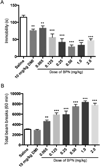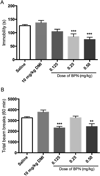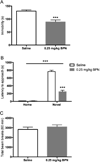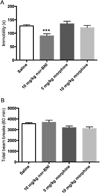Effects of buprenorphine on behavioral tests for antidepressant and anxiolytic drugs in mice
- PMID: 25178815
- PMCID: PMC4326609
- DOI: 10.1007/s00213-014-3723-y
Effects of buprenorphine on behavioral tests for antidepressant and anxiolytic drugs in mice
Abstract
Rationale: Buprenorphine (BPN) has been shown to rapidly improve mood in treatment-resistant depressed patients in small clinical studies. However, BPN's effects in preclinical tests for mood and antidepressant efficacy are largely unexplored.
Objective: The current study examined the effects of BPN in the forced swim test (FST) and novelty-induced hypophagia (NIH) test as measures of antidepressant and anxiolytic-like effects in C57BL/6 J mice. Microdialysis was used to measure whether BPN engaged kappa-opioid receptor (KORs) in the nucleus accumbens shell (NAcSh) at a behaviorally active dose (0.25 mg/kg).
Methods: BPN was tested in the FST at both 30 min and 24 h post-administration. Also measured in the FST at 24 h post-administration were the KOR antagonist norbinaltorphimine (nor-BNI), the MOR agonist morphine and the reference antidepressant desipramine. The anxiolytic effects of BPN were examined in the NIH test 24 h after treatment. The effects of acute injection of BPN and the KOR agonist U50,488 were measured on extracellular dopamine (DA) levels in the NAcSh.
Results: BPN produced significant reductions in FST immobility without changing locomotor activity and reduced approach latencies in the novel environment of the NIH test when tested 24 h after treatment. Repeated daily BPN injections for 6 days did not produce tolerance to these behavioral effects. nor-BNI produced a similar antidepressant-like response in the FST 24 h post-injection but morphine and desipramine were ineffective. BPN (0.25 mg/kg) did not alter DA levels when given alone but prevented the KOR agonist U50,488 from reducing DA levels.
Conclusions: Acute and subchronic treatment with BPN produced antidepressant and anxiolytic-like responses in mice at doses that engage KORs. These studies support the clinical evidence that BPN may be a novel rapid-acting antidepressant medication and provides rodent models for investigating associated neurochemical mechanisms.
Conflict of interest statement
IL was a consultant for Alkermes. EF, KM, and SAR have no conflict to disclose.
Figures






References
-
- Andrews CM, Lucki I. Effects of cocaine on extracellular dopamine and serotonin levels in the nucleus accumbens. Psychopharmacology. 2001;155:221–229. - PubMed
-
- Bechtolt AJ, Valentino RJ, Lucki I. Overlapping and distinct brain regions associated with the anxiolytic effects of chlordiazepoxide and chronic fluoxetine. Neuropsychopharmacology. 2008;33:2117–2130. - PubMed
Publication types
MeSH terms
Substances
Grants and funding
LinkOut - more resources
Full Text Sources
Other Literature Sources
Medical
Miscellaneous

